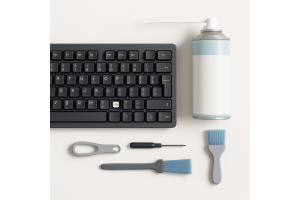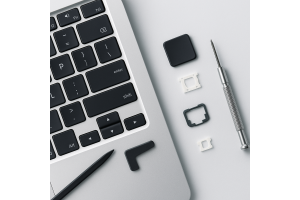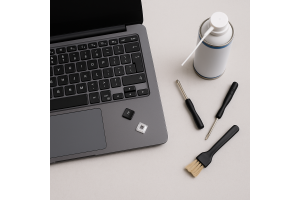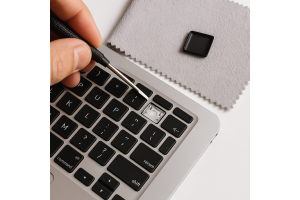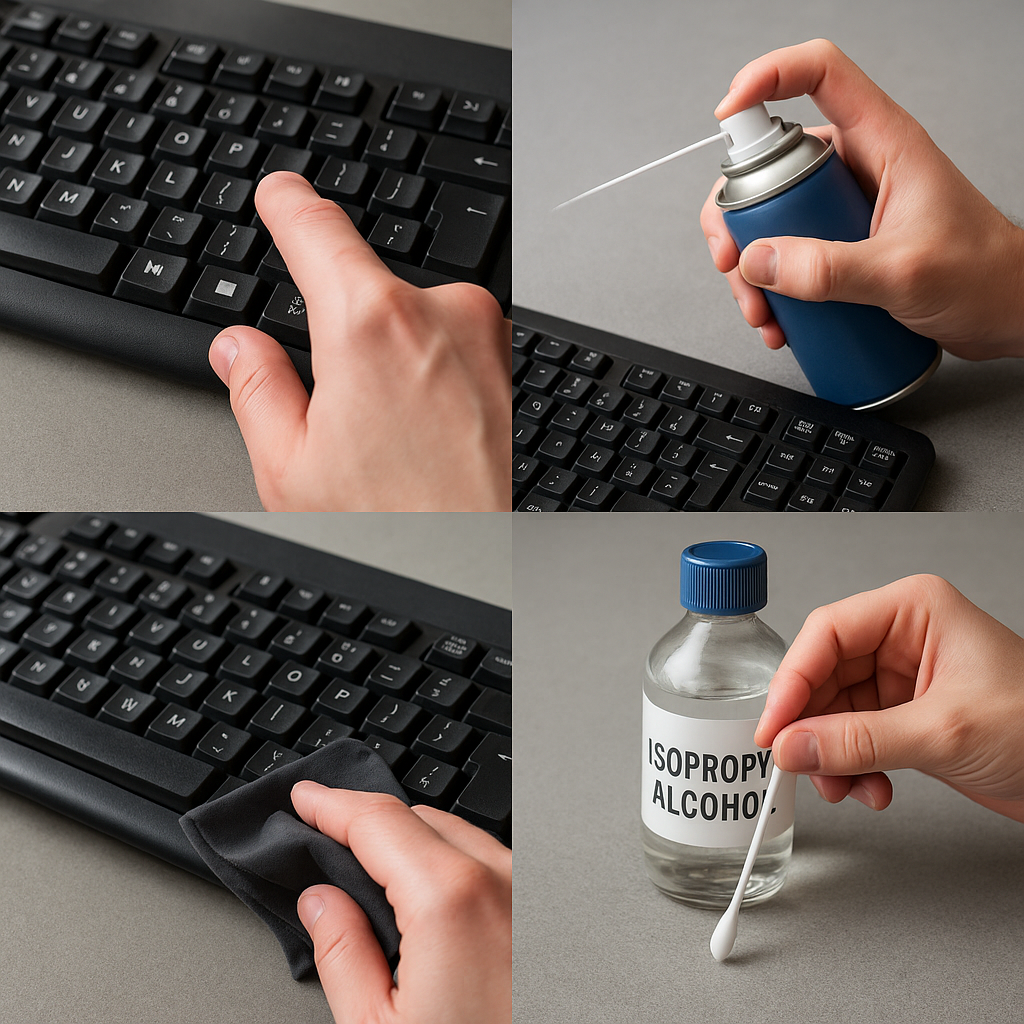
Table of Contents:
- Understanding the Importance of a Clean Keyboard
- Advantages of Scheduled Care
- Consequences of Neglect
- Step-by-Step: How to Clean Keyboard Keys
- Essential Safety Measures
- Choosing the Right Tools and Materials
- Recommended Brushes, Cloths and Compressed Air
- Using Isopropyl Alcohol and Other Cleaning Agents Safely
- Deep Cleaning Methods for Different Keyboard Types
- Cleaning Laptop and Wireless Keyboards
- Approaches for Mechanical and Desktop Keyboards
- Additional Tips and Best Practices
- Routine Care Essentials
- Conclusion
Regular upkeep of your device's input tools preserves functionality and hygiene. Whether using mechanical switches or membrane panels, proper maintenance prevents debris buildup and sticky responses. Professional care combines suitable tools with methodical techniques to safeguard delicate components.
Laptopkey.eu offers specialised solutions for diverse needs, including universal microfibre cloths and anti-static compressed air. These products cater to both casual users and professionals seeking efficient dust removal. Protective silicone covers further reduce wear for frequently used models.
Approaches range from surface-level brushing to targeted disinfection processes. Alcohol-based solutions (70% isopropyl) effectively address grime without harming electronics when applied correctly. Always power down devices and follow manufacturer guidelines to avoid liquid damage.
Key Takeaways
- Consistent maintenance prolongs equipment lifespan
- Specialist tools prevent accidental component damage
- Dry methods suit daily dust management
- Alcohol solutions require careful application
- Protective accessories minimise long-term wear
- Cost-efficient practices reduce replacement needs
Understanding the Importance of a Clean Keyboard
Maintaining hygienic input devices protects users and preserves performance. Dust particles and skin oils gradually compromise responsiveness, while microbial growth creates unhygienic workspaces. Proactive care prevents these issues before they escalate.
Advantages of Scheduled Care
Consistent upkeep delivers measurable benefits. Bacterial colonies shrink by 76% on sanitised surfaces, according to recent tech hygiene studies. Well-maintained components retain their tactile feedback three times longer than neglected ones.
Maintenance Frequency Common Issues Prevented Long-Term Advantages
Weekly
Dust accumulation
Sticky presses
Consistent tactile response
Monthly
Bacterial growth
Key wobble
Extended component lifespan
Quarterly
Switch corrosion
Debris jams
Reduced repair costs
Consequences of Neglect
Accumulated grime accelerates mechanical wear. Food crumbs and hair strands disrupt switch mechanisms, while liquid residues corrode electrical contacts. For irreparably damaged parts like retainer clips, Laptopkey.eu offers OEM-grade replacements compatible with major mechanical models.
Preventive measures prove more cost-effective than reactive solutions. Users spending five minutes weekly on maintenance save an average of £120 annually on professional repairs. Proper care also maintains resale value for premium devices.
Step-by-Step: How to Clean Keyboard Keys
Effective maintenance begins with thoughtful preparation. Always disconnect power sources and position absorbent materials beneath your workspace. This safeguards against accidental spills and simplifies post-cleaning debris collection.
Essential Safety Measures
Power down devices completely before starting. Position soft cloths beneath the work area to catch falling particles. Static-free brushes prove invaluable for dislodging crumbs without scattering them. Work systematically across rows, tilting tools at 45-degree angles to reach stubborn deposits.
Comparing Cleaning Approaches
Dry methods using soft-bristled tools remove 85% of surface contaminants, according to electronics maintenance specialists. For persistent grime, lightly dampen bristles with purified water – five drops maximum. Shake instruments vigorously to eliminate excess moisture before application.
"Proper technique matters more than frequency. Focus on thoroughness rather than speed during maintenance sessions."
Backlit models offer visual advantages during inspections. Use their illumination to spot missed particles in crevices. Finish by gently wiping surfaces with lint-free microfiber, rotating the towel frequently to prevent redepositing dirt.
Method Best For Precautions
Dry brushing
Loose debris removal
Avoid downward pressure
Damp wiping
Sticky residues
Test moisture on small area first
Choosing the Right Tools and Materials
Optimal maintenance outcomes depend on selecting equipment designed for delicate electronics. Specialised tools remove contaminants without scratching surfaces or displacing key mechanisms. Laptopkey.eu’s curated range addresses diverse needs through precision-engineered solutions.
Recommended Brushes, Cloths and Compressed Air
Firm-bristled brushes outperform rubber-tipped alternatives by dislodging debris more effectively. A 2023 electronics maintenance study found nylon bristles remove 37% more dust than silicone variants. Microfiber cloths with 300 GSM density prove ideal for trapping particles in tight spaces.
Tool Type - Anti-static brush, Compressed air, Microfiber cloth
Effective Use - Inter-key crevices, Blowing loose debris, Surface polishing
Product Example - Laptopkey.eu Detail Set, 240ml Anti-Moisture Can, Universal Cleaning Kit
Hold compressed air canisters upright during use. Short bursts prevent liquid propellant release that could damage circuits. For stubborn grime, Laptopkey.eu’s monitor foam works synergistically with their dual-layer cloths.
Using Isopropyl Alcohol and Other Cleaning Agents Safely
Seventy per cent isopropyl solutions strike the ideal balance between sanitisation and safety. Apply sparingly using lint-free swabs – excess liquid risks seeping beneath key mechanisms. Always test cleaners on inconspicuous areas first.
"Alcohol concentration directly impacts evaporation speed. Higher percentages leave components vulnerable to static buildup."
Cleaning Agent - 70% Isopropyl, Distilled water
Best Application - Disinfecting surfaces,Dampening cloths
Precaution - Avoid plastic edges, Wring thoroughly
For chemical-sensitive surfaces, specialised electronic wipes offer pre-moistened convenience. Store all cleaning solutions in temperature-controlled environments to maintain efficacy.
Deep Cleaning Methods for Different Keyboard Types
Specialised maintenance approaches become essential when addressing varied input device designs. Each construction type demands tailored techniques to remove embedded contaminants while preserving structural integrity.
Cleaning Laptop and Wireless Keyboards
Laptop models demand careful handling due to integrated components. Use compressed air at 15cm distance to dislodge debris without disturbing internal connections. For wireless versions, always extract batteries before applying slightly dampened swabs around power compartments.
Stubborn residues between fixed keycaps respond well to dental floss wrapped around a plastic card. Gently work horizontally to avoid damaging fragile scissor mechanisms. Laptopkey.eu provides OEM-compatible replacement switches if deep inspection reveals worn components.
Approaches for Mechanical and Desktop Keyboards
Mechanical designs permit complete keycap removal for thorough sanitation. Soak detachable components in lukewarm soapy water (40°C max) for 30 minutes, then air-dry upside-down. Desktop cases benefit from disassembly for internal brush cleaning.
Keyboard Type - Mechanical,Desktop
Optimal Method - Full disassembly, Case separation
Risk Factors - Switch spring damage, Ribbon cable mishandling
After deep cleaning mechanical models, inspect retainer clips for deformation. Laptopkey.eu stocks replacement parts for 89% of commercial switch types, ensuring continued functionality post-maintenance.
Additional Tips and Best Practices
Sustaining peak performance requires daily attention to detail. Simple habits dramatically reduce contamination risks while preserving tactile responsiveness. Focus on prevention rather than reaction for lasting results.
Routine Care Essentials
Weekly wipe-downs with antimicrobial cloths combat germ proliferation. Target gaps between keycaps using cotton buds dipped in distilled water. Rotate cleaning tools frequently to avoid redistributing grime.
- Install silicone covers during inactive periods
- Store compressed air cans upright
- Inspect bristles monthly for wear
Frequency Task Tool
Daily
Surface dusting
Microfiber cloth
Weekly
Inter-key sanitation
Antiseptic wipes
Monthly
Deep sanitisation
Isopropyl solution
"Preventive care slashes repair costs by 62% compared to reactive approaches," notes tech maintenance specialist Clara Winslow.
Position workstations away from open windows to minimise dust ingress. For shared devices, implement mandatory hand-cleaning protocols. Address spills immediately using barely dampened cloths – never pour liquids directly onto components.
Persistent stickiness under keycaps often signals needed replacements. Laptopkey.eu stocks OEM-compatible parts for swift DIY repairs. Consider professional servicing when multiple keys exhibit unresponsive behaviour despite thorough cleaning attempts.
Conclusion
Preserving your keyboard’s performance begins with methodical care routines. Consistent maintenance prevents sticky residues and extends component lifespan. Prioritise quality tools like anti-static brushes and compressed air for efficient crumb removal.
Allocate time weekly for surface wiping with a slightly dampened paper towel. Monthly deep cleans address hidden debris in mechanical models. Always power down devices and avoid excessive moisture during sessions.
Long-term benefits include reduced repair costs and maintained tactile feedback. For stubborn grime, use folded paper towel edges dipped in 70% isopropyl alcohol. Store accessories properly to ensure readiness for future sessions.
Persistent issues may signal worn switches needing replacement. Quality parts restore functionality without compromising device integrity. Establish a schedule balancing thoroughness with practicality for lasting results.

